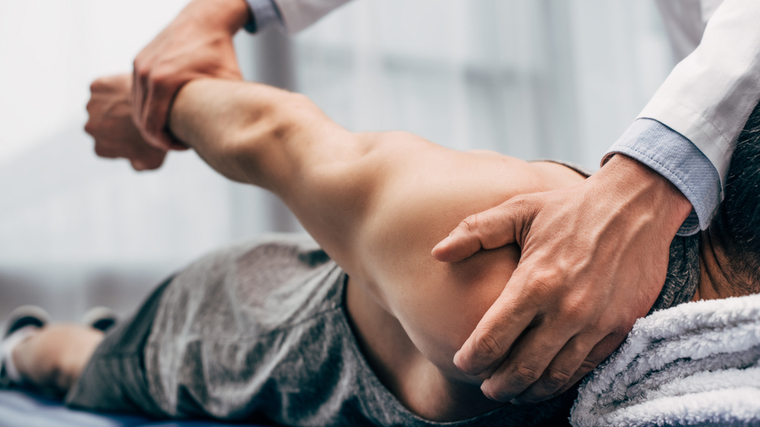Whether you’re recovering from a training injury or are “I slept in the wrong position and now everything hurts” years old, you’re probably familiar with the aches and pains of being human.
Ice baths and heating pads may give you temporary relief when your body is acting up. In an attempt to quell your aches and pains, you’ve probably thought about trying chiropractic care. Maybe you’ve landed on this article after a recommendation from your suddenly pain-free gym buddy.

If you’ve never seen a chiropractor as part of your recovery regimen, it might be worth taking some time to figure out what a chiropractor does, what some risks might be of getting a chiropractic adjustment, and if a few sessions could become part of your routine.
Editor’s note: The content on BarBend is meant to be informative in nature, but it shouldn’t take the place of advice and/or supervision from a medical professional. The opinions and articles on this site are not intended for use as diagnosis, prevention, and/or treatment of health problems. Speak with your physician if you have any concerns.
What is Chiropractic Care?
Chiropractic care is a holistic form of body therapy that primarily focuses on your spine, joints, and musculoskeletal system. The idea is that if you can move around day-to-day with less pain, you’ll be able to live an overall healthier and more functional life.
One of the principles the practice was built upon, called vertebral subluxation, is a concern about health located in your joints that chiropractors attempt to address. This concept has faced a lot of criticism in the medical community, much of which suggests that chiropractic care doesn’t seem to actually “fix” injuries or ailments. (1)(2)
However, many modern chiropractors now integrate principles of traditional physical therapy alongside spinal manipulative therapy (SMT). (3) And while chiropractic care may not directly resolve health issues, patients report a lot of short-term satisfaction from the practice on the whole. (4)
What Does a Chiropractor Do?
Chiropractors are health care professionals who help diagnose, treat, and prevent neuromusculoskeletal system disorders. (5) A chiropractor uses their hands and/or special tools to perform joint and spinal adjustments to help correct misalignments, reduce pain, and improve overall function. They use what is called joint or spinal manipulation to help move your joints into a better position.
If you’ve never been to a chiropractor before, Dr. Jeffrey Mechtenberg, D.C., gives some insight on what an initial exam might look like.
“I start with an overall general history of the patient,” he says. “I then start addressing the patient’s chief complaint and dive deeper into questioning to find the likely origin of the pain, whether it is an acute (new injury) or a chronic condition. After the history, I perform a general range of motion examination, orthopedic testing, and functional movement testing to help narrow in on the cause of the pain and other affected areas the patient might be unaware are contributing to the pain.”

Chiropractors aim to help different types of pain, strains, and aches — from your jaw down to your ankles and all throughout your body. They do not prescribe medication, so for some, this type of healthcare can be considered alternative medicine.
Spinal Manipulation
The most commonly understood purpose of a chiropractic is to perform adjustments to help realign the joints. This can be referred to as spinal manipulation or SMT. The chiropractor uses their hands or an instrument to apply controlled force to a joint of the spine. SMT can be used as a treatment for low back and neck pain, headaches, and sciatica. (6)
Joint Manipulation
A chiropractor can adjust the joints in your spine, but they can also adjust the joints in your shoulders, elbows, wrists, hips, knees, and ankles. The purpose of joint manipulation is to help reduce pain and improve your joint’s range of motion. You may appreciate this technique if you’ve experienced overuse or underuse of a joint, post-op or trauma side effects, or natural joint dysfunction.
Soft Tissue Therapy
Massage therapy can be a beneficial way to help muscle recovery, improve blood flow, and boost athletic performance. Soft tissue therapy is not as intense as deep tissue massage, and it can involve a variety of depths and pressure.

This technique is intended to improve soft tissue flexibility, range of motion, and reduce pain. (7)
Kinesio Taping
Commonly known as KT tape, kinesiology tape sticks to your skin and lifts it slightly from the muscle tissue below. That lifting pressure can slightly increase the space in your joints, which can in turn help reduce pain while improving grip strength and function. (8)
Recommend Stretches
Maintaining flexibility is important for physical performance and your daily function. A chiropractor can help improve your flexibility by not just adjusting your joints but also recommending beneficial stretches for you to perform on your own.
Having a tight chest, shoulders, and back can contribute to a sunken posture that might cause you pain. A chiropractor may recommend the best stretches to help address your specific issues. They might also recommend stretches that help reduce pain and improve function.
Nutritional Counseling
Chiropractors can’t prescribe medication, but some are certified to offer nutritional counseling that may ease body aches and specific joint pain.
Diets high in sodium and fat is said to be associated with heart disease, hypertension, and diabetes, to name a few potential ailments. (9) Having certain diseases can increase complications and pain at joint and muscular levels, so finding what foods your body needs most might be able to help ease pain.
Factors to Consider Before Visiting a Chiropractor
If your only experience with chiropractic care are videos on YouTube, you probably (and understandably) have a ton of questions bouncing around your brain. But first: Always consult with your primary care physician for their opinion and a recommendation. The physician can also help decide whether chiropractic care is right for you by checking for conditions or diseases that may need further attention.
Your Health History
Chiropractors need to be aware of your health history before proceeding with your treatment, says Dr. Ben Burton, D.O.
“Patients with certain autoimmune diseases, bone density issues, hypermobility syndromes, diseases of their blood vessels, or other serious diseases need to make sure their chiropractor is aware of these conditions.”

Athletes who are living with severe osteoporosis, numbness or tingling in a limb, spinal cancer, a herniated disc, or those with an increased risk of strokes should likely avoid seeing the chiropractor. (10)
Your Current Medical and Training Needs
If you’re having pain and want to have a chiropractor take a look, you may want to make sure you’re getting screened for other pressing needs.
“I make sure serious diseases are ruled out that may require surgery or medications,” Burton says. “After that, I suggest chiropractic care along with physical therapy and massage. The additional benefit of chiropractics is for chronic or recurrent back symptoms. If a patient’s back goes out regularly, and they know chiropractics can help, they can often get in to see a chiropractor and get their symptoms resolved promptly.”
So if your form is on point but a past injury keeps flaring up every time you overhead squat even when you do mobility exercises, you could take them out of your program. Or, you could potentially see your chiropractor to see if they can help improve your pain levels enough to so you’re regularly overhead squatting safely.
Research has shown that although there are patients who experience adverse effects after seeing a chiropractor, about half of the patients recovered after just their fourth visit, and only one percent reported still being affected after 12 months. (11)
Risk of Injury
Visiting a chiropractor can present potential benefits for easing pain or discomfort throughout the body, but there is some controversy behind the practice. The manipulation of two vulnerable areas — your neck and your spine — can present dangers, even when people are in good health.

The quick thrusting adjustment to the neck that many chiropractors use — called cervical manipulation — has been shown to produce strain on carotid and vertebral vessels. (12) These are arteries that are located on either side of the neck and supply blood flow to the brain. Straining these vessels can cause dissection, which may be responsible for at least 20 percent of ischemic strokes in young people. (13)
Spinal manipulation, which many chiropractors deploy for adjusting your back, also has risk factors associated with it. Some of its more mild side effects can be headache, fatigue, or discomfort, however there are more serious side effects that include stroke, paralysis, fractures, and even death. (14)
Your Chiropractor’s Qualifications and Practices
It’s extremely important to verify a chiropractor’s credentials and legitimacy. Getting a referral from a primary care physician can help ensure you’re in the right hands.
“Be very pragmatic,” Burton says. “If chiropractic care is effective, patients should notice an improvement in their symptoms after one or two treatments. Different chiropractors have different techniques and skills. It may be worth getting a recommendation from a friend and trying a few to find the one that is the most therapeutic.”
Potential Benefits of Visiting a Chiropractor
When it comes to any kind of healthcare, it’s not a one-size fits all. What might be beneficial to one patient could be counterproductive to the next. Seeing a chiropractor could provide different types of benefits for different types of athletes.
Reduced Low Back Pain
Lower back pain is the second most common reason individuals see a healthcare professional. (15) If you suffer from low back pain, you may also deal with the fear of triggering the pain, decreased sexual function, and mental health issues such as anxiety, depression, and stress. (16)
[Read More: Best Lower Back Exercises for Strength and Reduced Pain]
A chiropractor can perform spinal manipulation to reduce these symptoms. Patients who visit a chiropractor regularly may experience a reduction in flare-ups for chronic low back pain. (17)
Reduced Neck Pain
Many athletes live with neck pain, which can come from sudden force injuries like whiplash, straining it while lifting, or painful posture. This kind of pain is one of the main reasons people seek a chiropractor’s services. (18)

Untreated chronic neck pain can impact your ability to work out, and make it harder to do your job or even relax. Chiropractors can perform cervical manipulation to help loosen the joints in your neck. This type of manipulation can be effective for treating neck pain and disabilities caused by it. (19)
Lowered Risk of Opioid Prescriptions Misuse
To help manage pain, patients may be prescribed an opioid by their doctor. Although it may seem helpful, opioid prescriptions could lead to a reliance on them, which can then lead to addiction and overdose. About 21 to 29 percent of patients prescribed opioids misuse them, and between four to six percent of patients transition to heroin. (20)
Chiropractic care does not use medication for pain relief. Research shows that patients who saw a chiropractor in addition to their primary care physician experienced half the risk of being prescribed an opioid. (21)
Headache Relief
Headaches can be caused by a multitude of factors, such as your posture, stress, injury, poor nutrition, or lack of sleep. They can range from mild tension headaches to debilitating migraines, which are experienced by 35 million Americans. (22)

Patients may visit a chiropractor to help relieve their headaches through spinal or cervical manipulation. Chiropractic care has been shown to contribute to headache relief, especially when the source is a pinched nerve or misaligned joints. (23)
Improved Posture
Stiff posture can cause pain and other issues in the spine and throughout the body. A few common postural imbalances are kyphosis (rounded shoulders), lordosis (an anterior tilt of the pelvis), forward head posture (where your head sticks out in front of your shoulders), or scoliosis (sideways curvature of the spine).
A chiropractic can perform adjustments, as well as provide stretching and strengthening exercises, to help improve posture. With a combination of those adjustments, stretching, and strengthening exercises, your posture can improve and pain levels may then reduce. (24)
Improved Range of Motion
Range of motion (ROM) is important for anyone who wants to reach the fancy glasses on the high shelf. But for athletes, a limited range of motion can be detrimental to their performance or increase their risk of injury. “Weightlifters are putting loads of stress through their body,” Dr. Mechtenberg says. “Chiropractic care helps improve ROM and addresses imbalances throughout the body. By helping the body function at its highest possible capacity, you will reduce injury and healing times.”
Chiropractor Red Flags
First and foremost, you want to make sure your chiropractor is licensed and has all the certifications they need to treat you. If you’re into a specific strength sport, you might also want to look for a chiropractor that has experience treating other athletes like you.
Make sure your potential chiropractor demonstrates an active interest in who you are as an athlete and in your health history, advises Dr. Burton. “Patients should be cautious about receiving care from a chiropractor that is not interested in their medical history,” he says.
Additionally, Dr. Burton explains that your chiropractor should tailor your care to you as an individual rather than trying to sell you a certain number of sessions upfront. “I am skeptical of chiropractors that commit patients to multiple treatments over multiple weeks to resolve their symptoms,” he says.
Instead, think of your relationship with your chiropractor as a give-and-take, where they actively listen to your decription of your pain and function and are willing to adjust their treatment accordingly.
Final Thoughts
Many factors go into staying healthy on the inside and out. Living an active lifestyle can be great for your overall health, but you also may still find yourself with aches and pains. Seeking chiropractic care — while not without its risks — may be able to help soothe your body and bring you up to peak condition.
Whether you’re looking to improve your performance in the weight room or decrease your pain levels standing up after hours of video gaming, visiting a chiropractor may be able to help.
References
- Keating JC Jr, Charlton KH, Grod JP, Perle SM, Sikorski D, Winterstein JF. Subluxation: dogma or science?. Chiropr Osteopat. 2005;13:17.
- Marcon AR, Murdoch B, Caulfield T. The “subluxation” issue: an analysis of chiropractic clinic websites. Arch Physiother. 2019 Nov 13;9:11.
- Annemarie de Zoete, Sidney M. Rubinstein, Michiel R. de Boer, Raymond Ostelo, Martin Underwood, Jill A. Hayden, Laurien M. Buffart, Maurits W. van Tulder, G. Bronfort, N.E. Foster, C.G. Maher, J. Hartvigsen, P. Balthazard, F. Cecchi, M.L. Ferreira, M.R. Gudavalli, M. Haas, B. Hidalgo, M.A. Hondras, C.Y. Hsieh, K. Learman, P.W. McCarthy, T. Petersen, E. Rasmussen-Barr, E. Skillgate, Y. Verma, L. Vismara, B.F. Walker, T. Xia, N. Zaproudina, The effect of spinal manipulative therapy on pain relief and function in patients with chronic low back pain: an individual participant data meta-analysis, Physiotherapy, 112:121-134.
- Hays RD, Sherbourne CD, Spritzer KL, Hilton LG, Ryan GW, Coulter ID, Herman PM. Experiences With Chiropractic Care for Patients With Low Back or Neck Pain. J Patient Exp. 2020 Jun;7(3):357-364.
- Salehi, Alireza, Hashemi, Neda, & Hadi Imanieh, Mohammad. Chiropractic: Is it Efficient in Treatment of Diseases? Review of Systematic Reviews. International Journal of Community Based Nursing and Midwifery. 2015; 3(4).
- Spinal Manipulation: What You Need to Know. National Center for Complementary and Integrative Health. 2019. https://www.nccih.nih.gov/health/spinal-manipulation-what-you-need-to-know
- Dolder, Paul van der, Ferreira, Paulo, Refshauge, Kathryn. Is soft tissue massage an effective treatment for mechanical shoulder pain? A study protocol. Journal of Manual and Manipulative Therapy. 2010; 18(1). doi: 10.1179/106698110X12595770849687
- Dilek, B., Batmaz, I., & Nas, K. Kinesio taping in patients with lateral epicondylitis. Journal of Back and Musculoskeletal Rehabilitation. 2016. DOI:10.3233/BMR-160701
- Kyung Lee, Mi, Amorin-Woods, Lyndon, & Cascioli, Vincenzo. The use of nutritional guidance within chiropractic patient management: a survey of 333 chiropractors from the ACORN practice-based research network. Chiropractic and Manual Therapies. 2018; 26. doi: 10.1186/s12998-018-0175-1
- Chiropractic Adjustment. MayoClinic; 2020. https://www.mayoclinic.org/tests-procedures/chiropractic-adjustment/about/pac-20393513
- Rubinstein, Sidney M, Leboeuf-Yde, Charlotte, & Knol, Dirk L. The Benefits Outweigh the Risks for Patients Undergoing Chiropractic Care for Neck Pain: A Prospective, Multicenter, Cohort Study. Journal of Manipulative and Physiological Therapeutics. 2007; 30(6). DOI:https://doi.org/10.1016/j.jmpt.2007.04.013
- Turner, Ryan C, Lucke-Wold, Brandon P, & Boo, Sonyun. The potential dangers of neck manipulation & risk for dissection and devastating stroke: An illustrative case & review of the literature. Biomed Res Rev. 2018; 2(1). doi: 10.15761/BRR.1000110
- Britt, Todd B, Agarwal, Shashank. Vertebral Artery Dissection. StatPearls Publishing. 2021.
- Nielsen, Sabrina Mei, Tarp, Simon, & Christensen, Robin. The risk associated with spinal manipulation: an overview of reviews. Systemic Reviews. 2017; 6. doi: 10.1186/s13643-017-0458-y
- Khodakarami, Nima. Treatment of Patients with Low Back Pain: A Comparison of Physical Therapy and Chiropractic Manipulation. Healthcare(Basel). 2020; 8(1). doi: 10.3390/healthcare8010044
- Grabovac, Igor, Ernst Dorner, Thomas. Association between low back pain and various everyday performances : Activities of daily living, ability to work and sexual function. Wiener Klinische Wochenschrift. 2019; 131. doi: 10.1007/s00508-019-01542-7
- Hays, Ron D., Sherbourne, Cathy D., & Spritzer, Karen L. Experiences With Chiropractic Care for Patients With Low Back or Neck Pain. Journal of Patient Experience. 2019. https://doi.org/10.1177/2374373519846022
- Haneline, Michael T, Cooperstein, Robert. Chiropractic care for patients with acute neck pain: results of a pragmatic practice-based feasibility study. Journal of Chiropractic Medication. 2009; 8(4) doi: 10.1016/j.jcm.2009.08.003
- Hurwitz, Eric L., Morgenstern, Hal, & Harber, Phillip. A Randomized Trial of Chiropractic Manipulation and Mobilization for Patients With Neck Pain: Clinical Outcomes From the UCLA Neck-Pain Study. American Public Health Association. 2002; 92(10). doi: 10.2105/ajph.92.10.1634
- Opioid Overdose Crisis. National Institute on Drug Abuse. 2021. https://nida.nih.gov/drug-topics/opioids/opioid-overdose-crisis
- Whedon, James M, Toler, Andrew W J, & Kazal, Louis A. Impact of Chiropractic Care on Use of Prescription Opioids in Patients with Spinal Pain. Pain Medicine. 2020; 25(21). doi: 10.1093/pm/pnaa014
- Chaibi, Aleksander, Tuchin, Peter J. Chiropractic spinal manipulative treatment of migraine headache of 40-year duration using Gonstead method: a case study. Journal of Chiropractic Medication. 2011; 10(3). doi: 10.1016/j.jcm.2011.02.002
- Bryans, Roland, Descarreaux, Martin, & Duranleau, Mireille. Evidence-Based Guidelines for the Chiropractic Treatment of Adults With Headache. Journal of Manipulative and Physiological Therapeutics. 2011; 34(5) DOI:https://doi.org/10.1016/j.jmpt.2011.04.008
- Castello Branco, Kim, Moodley, M. Chiropractic manipulative therapy of the thoracic spine in combination with stretch and strengthening exercises, in improving postural kyphosis in women. ScienceDirect. 2016; 21. https://doi.org/10.1016/j.hsag.2016.06.001
Featured Image: Konstantin Shadrin / Shutterstock